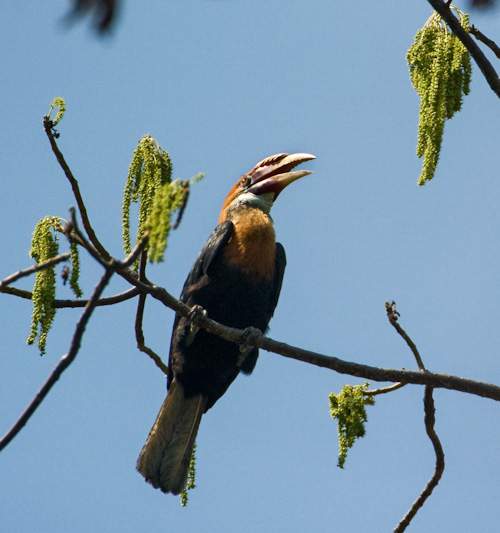Narcondam Hornbill
- The Narcondam hornbill (Rhyticeros narcondami) is a small, distinctive, dark hornbill, measuring 45 to 50 cm in length.
- They are monogamous, non-migratory resident birds showing sexual dimorphic.
- This species is endemic to the tiny (6.8 sq.kilometers) dormant volcanic island of Narcondam, forming part of the Andaman Islands, India.
- It is resident in fairly open mixed forest, which covers most of the island, from sea-level to the peak
- This hornbill is listed as “Endangered” in IUCN red list and CITES Appendix II.
- It is protected under the Wildlife Protection Act and Narcondam Island is a wildlife sanctuary, near Myanmar’s Coco Island.
- The Important Bird and Biodiversity Area (IBA) of these hornbill species in India is the Narcondam Island Wildlife Sanctuary.
- Its population appears to be stable despite some degree of hunting and habitat degradation.

Narcondam Hornbill
Mission Seven Summits
- It is a unique series of mountaineering expedition launched by Indian Air Force (IAF).
- The mission’s aim is to fly the tricolour and the IAF flag on the highest peaks in every continent.
- A team of Mountaineers recently scaled Mt Vinson in Antarctica. With this, IAF becomes the first organisation in India to achieve this unique feat.
World’s First Photovoltaic Highway
- World’s first solar highway in Jinan, the capital city of China's Shandong province was recently opened for testing.
- The new solar road consists of an insulating layer on the bottom, photovoltaic panels in the middle, and transparent concrete on top.
- It can generate 1 million kilowatt-hours of power in a year and saves the space for building solar farms and shorten the transmission distance.
Umananda Island
- It is the smallest inhabited river island in the world.
- It is situated in the river of Brahmaputra in Assam.
- According to the Hindu mythology, Lord Shiva lived in the island much to the ananda or joy of his consort Uma, another name for Parvati, hence the name ‘Umananda’.
- It is also known as Peacock island, because it resembled a peacock’s feathers splayed in full view.
- Golden Langur, one of the most endangered species of primates is found in this island.
- Golden langurs are found only in parts of Western Assam and the neighbouring foothills of the Black mountains of Bhutan.
Agariyas
- Agariyas are nomadic tribes and traditionally salt farmers in Rann of Kutch, a seasonal salt marsh in Thar Desert, Rajasthan.
- The tribes derive their names from the word “Agar” meaning salt farms.
- During the monsoon months, the Rann of Kutch is submerged in sea water.
- As the sea water finally begins to recede in October, the Agariyas move in and begin the elaborate process of salt farming.
- This salt is different from the marine salt produced on the coast and is locally known as Badagara, literally meaning Bada (big) and Agara (pan).
- They suffer from skin lesions, severe eye problems, tuberculosis and abnormally thin legs, stiff with years of exposure to high concentration of salt.
- After the salt production season, they move to the peripheral villages.
- High Temperature, high wind velocity and high soil salinity makes Rann of Kutch an ideal place for salt production.
- It is home to rare breed of wild ass and flamingos.
Dhanush Artillery Gun
- Dhanush is an upgraded version of the Swedish bofors howitzers.
- It is a 155 mm gun with a maximum range of 40 km compared to 17 –km range of the original guns.
- It is expected to be inducted in the Indian Army by 2018.
- Army is keen on inducting Dhanush since it has not inducted any new artillery gunds since the Bofors procured in 1980’s form Sweden.
Source: The Hindu, PIB
